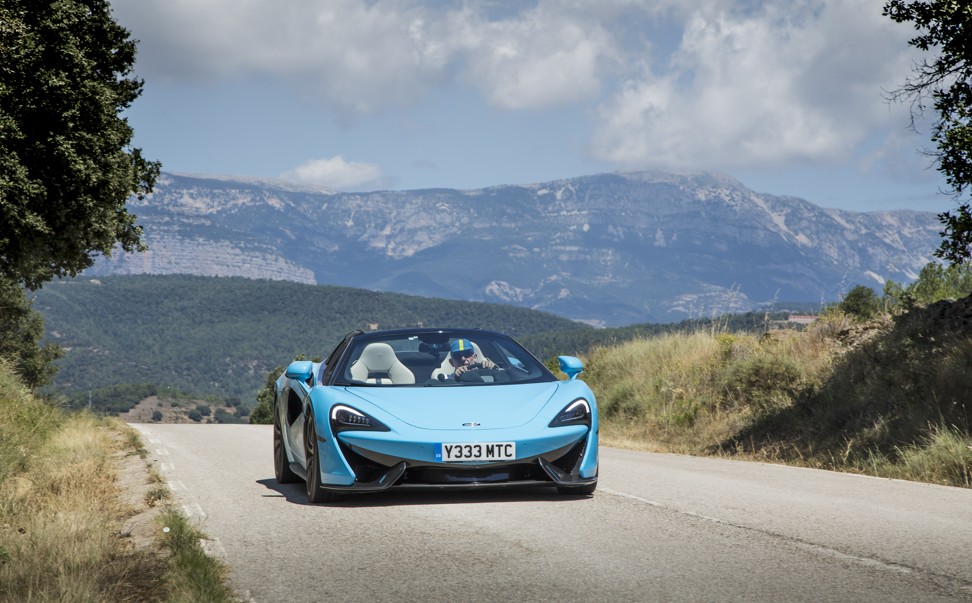
Mind the doors: Stunning McLaren 570S Spider draws Catalan crowds and sizzles on the road to Andorra
Majestically proportioned two seater threatens Lamborghini and Ferrari with exceptional acceleration and roadholding in northern Spain
The lithe, laser-guided opposition-defence-shredder that is Lionel Messi’s left foot. The impossibly intricate exultation of Antoni Gaudi’s Sagrada Familia: piety rendered in stone. The wondrously phantasmagorical visions of supreme surrealist Salvador Dali.
All local boys – after a fashion – made good; their greatest creations forged in the crucible of creativity that is Barcelona, the glamorous, and newly defiant, city by the sea and cultural capital of Spain, never mind Catalonia.
There isn’t much that could hold a votive candle to all that towering talent, you might think; little point in setting yourself up to fall flat on your cylinder head gasket. Unless … you are McLaren Automotive and you have a cunning plan.
But cunning plan or not, you’d still need some impressive hardware to stand up to the overwhelming bounty of Barcelona: glide forward the McLaren 570S Spider, the latest supercar for the generally rich and a machine that’s just generally super.

The test car then roared around a disbelieving Christopher Columbus – today figuratively flipping the bird to all vile fanatics from atop his monument at the end of La Rambla – and out into the sizzling heat of the country, northwest towards Lladurs and the distant Pyrenees of Andorra. Cheering, that is, when they weren’t frantically snapping pictures or quickly selecting video mode as the Spider approached, to grab their sliver of reflected glory.
With a largely spectacular three-hour drive each way, McLaren sent drivers out in teams of two; and any unintentional Le Mans reference seemed appropriate the moment my track-experienced co-driver hit highway speeds of … well, let’s say speeds that should have interested the Spanish constabulary.

The two-seat convertible Spider joins the 570GT and 570S Coupé in McLaren’s Sports Series stable. Another mid-engined extrovert for drivers who like to feel the road via McLaren’s hydraulically assisted – rather than electric – power steering, it costs a wallet-worrying HK$3.63 million (US$464,000), basic. For that, you can help yourself to 570 horsepower (hence the designation), seven-speed dual-clutch automatic transmission; Sport, Comfort and Track driving profiles; 100km per 10.7 litres of petrol and a 3.8-litre, V8 twin-turbo engine producing a thumping 600Nm of torque at 5,000rpm.
All that oomph means that when putting the boot in on the accelerator, in a car that hits 100km/h in 3.2 seconds, one is thrown back into one’s seat as if on lift-off. At such moments the optional, snug-fit racing-style seats would represent a worthwhile investment.
A car that looks like a movie star on wheels scarcely needs to shout about its arrival, but that’s what the Spider does when fitted with McLaren’s sport exhaust. The V8’s rumbling roar is amplified by a resonator pipe, which gives startled spectators something to talk about for weeks and makes for particular fun in mountain tunnels. They’re innumerable between Barcelona and Lladurs and help turn that roar into a screaming banshee wail.

It’s difficult to find fault with such a graceful, majestically proportioned machine, but unless you were competent at gymnastics at school, entry to and egress from the low-slung Spider, with its up-and-out dihedral doors, could prove testing.
When the car has gone topless in the sunshine, of which there was plenty in Spain, the seven-inch touch-screen is almost unreadable; but a different visibility problem arises when the driver must peer round the chunky A-pillars. Still, even Karlie Kloss probably has a small defect or two, somewhere.
Maintaining inadvisable speeds on the Catalonian country roads was undeniably entertaining, especially in manual mode; and at no time did the rear-wheel drive Spider, with carbon-ceramic brakes and roadholding like that of a limpet with abandonment issues, seem intent on careering into a ditch. Even if it had, its reassuringly strong carbon-fibre body would no doubt have come to the rescue of its Spider-men.
Having set about producing road, rather than exclusively Formula 1, cars relatively recently, McLaren remains the new kid on the supercar block. But last year it almost managed to double its previous best sales figures, to 3,286 units.
With the Spider widely tipped in the industry to be a premium performer, even the likes of Lamborghini might eventually be specks in McLaren’s rear-view mirror.

